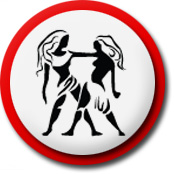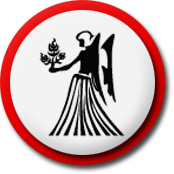Lal Kitab is a system of astrology prediction. This system has been introduced by Pandit Roop Chand Joshi. It is said that Lal Kitab has been dictated by a spirit in a poetical way to Panditji. He has great respect for this book and he put red colour cover on it. In India red colour is taken as a symbol of auspiciousness. So, Lal Kitab is synonyms of auspicious book. Later on his written work took the shape of books namely 'Farmaan', 'Armaan', 'Lal Kitab - Part-III, Lal Kitab - Tarmeemshuda and Jyotish ki Lal Kitab. These books have been written in Urdu language as those days Urdu has the same status as English language has today in India.
Salient Feature of Lal Kitab
Lal Kitab is a meticulous work comprising palmistry and astrology. The first part of this great treatise contains the principles and Sutras for interpretation of horoscope, termed as "Vyakaran". The birth chart of an individual is prepared like the traditional Parashar principles, but the only important difference is that the Rashis are not considered or taken into account for predictive astrology and, therefore, the digits indicating the Rashis in a traditional birth chart are scrapped. Secondly, for predictive purposes the ascendant is treated as the first house and it is regarded as the house of the first Rashi, i.e., Aries and counting progressively in a sequence up to the 12th house being that of Pisces.
Another part is Palmistry. Ordinarily the palmists talk of mounts and lines Sun, Moon and Mars etc. but it is in Lal Kitab only that we comes across the birth charts of the natives having twelve houses and all the planets (earliest known nine planets) posted there. Rules of prediction are also very much like those enunciated in astrology. Despite all this, the astrology of Lal Kitab is different from astrology we know of, be it eastern, western or of any origin. The astrological contents that are added to it are to reflect the findings of a palmist or rather to corroborate it.
The palm has been divided into 12 parts just as the natural Zodiac is divided into twelve signs like Aries, Taurus etc. Some types of shapes have been allotted to planets. These shapes wherever they exist on palm are supposed to be occupying particular houses of the birth chart. These signs represent the planets they are allotted to. Thus we have the twelve houses and the nine planets posted in the chart having twelve houses. The astrological chart is ready on the basis of the palm. They are often different from the birth charts prepared on astrological principles. The authenticity of astrological charts is to be corrected by the chart prepared from palm imprints. How charts are made from the palm is not our subject here.
The palm has been divided into 12 parts just as the natural Zodiac is divided into twelve signs like Aries, Taurus etc. Some types of shapes have been allotted to planets. These shapes wherever they exist on palm are supposed to be occupying particular houses of the birth chart. These signs represent the planets they are allotted to. Thus we have the twelve houses and the nine planets posted in the chart having twelve houses. The astrological chart is ready on the basis of the palm. They are often different from the birth charts prepared on astrological principles. The authenticity of astrological charts is to be corrected by the chart prepared from palm imprints. How charts are made from the palm is not our subject here.
Whatever be the system or method of preparation the chart has ascendant or the lagna and the other twelve houses numbered serially. Though they are the 12 sings of the Zodiac the signs have no significance in the chart. For signs, we may say, each horoscope is to be treated just like the horoscope of Kala Purusha; that is, house No. 1 should be considered as identical with Aries in all cases. As Sun is exalted in Aries and debilitated in Libra, we say that Sun is exalted in Lagna and debilitated in the 7th house. The lordship of the houses will also go likewise. Mars is always the lagna Lord and Venus the 7th Lord.
In the palm we talk of lower Mars and upper Mars. In Lal Kitab's astrology we have two Mars, one a malefic or bad Mars and the other a benefic or a kind of good Mars. This is one peculiarity of Lal Kitab's astrology. Both the Mars have their own properties.
As regards the comparative power of the planets it is the same as given in classical texts but at the same time we come across the concept of equivalent planets. Mercury for instance, is considered to be equivalent to Sun in power of giving results.
In Lal Kitab, there is a concept of blind or sleeping planets and blind or sleeping houses. The planets are supposed to have an aspect of some houses and affect the results of those houses. In Lal Kitab if the aspecting planet has no planet in the aspected house the aspecting planet becomes a blind planet in the aspected house the aspecting planet becomes a blind planet himself. It may be pertinent to note that the aspect of the planet is not the same in each house. Sun if posited in house 2 shall not aspect the 8th house but the 6th house only and if 6th house is unoccupied sun becomes blind. In short it is the house that grants aspect to the planet. The house is blind if it has no planets in it. This is the concept in astrology also. We call that house as weak.
There is also a concept of the artificial planets (Banawati or Masnoi Graha). A group of two planets together form one particular artificial planet or a substitute of that planet. Sun and Venus together form one artificial Moon. Likewise there are artificial planets for each of the planets including the nodes Rahu and Ketu.
There is also a concept of scapegoat or sacrificial goats (Kurbani Ka Bakaraa). If, suppose, Sun is afflicted by Saturn the effects of Sun shall be affected. This will not affect the effects of any other planet like Mars, Mercury or Rahu etc.
According to Lal Kitab the affliction of Sun shall be passed on to Ketu. In other words the affliction would affect the results of Ketu. The affliction of Saturn would be spoilt. The wife of the native may die or suffer from miseries and troubles. It may be brought on record that such effects have actually been noticed although Saturn does not represent wife nor he is the significator of wife. Such results do need a deep research and the results are likely to enrich our astrology.
There is a basic assumption that a planet gives the results of the houses of his lordship and those of the house occupied by him. He may, according to some, also offer the results of house or houses of which he is the natural significator although we have our own reservations but the planet in Lal Kitab can give results of any house by applying suitable remedies. This is a revolutionary concept and really needs deep research work like the assumption of sacrificial goats referred to above.
These are some of the special features of Lal Kitab's astrology. They may look strange but it should be remembered that the basis of astrology in Lal Kitab is palmistry. Some of these features are useful in suggesting remedies. The concept of artificial planets particularly is of great help in remedies against planetary ills. Mercury is an enemy of Jupiter. If Mercury afflicts Jupiter we may try to help Jupiter because the group of Jupiter and Rahu together is an artificial Mercury. If Jupiter is propitiated Mercury shall lose half of his strength and Jupiter shall become extra strong. In case Jupiter afflicts Mercury we should propitiate Venus because Sun and Venus constitute Jupiter. By strengthening Venus we shall be increasing power of Mercury (Venus is Mercury's friend) and decreasing the power of affliction of Jupiter.
In the palm we talk of lower Mars and upper Mars. In Lal Kitab's astrology we have two Mars, one a malefic or bad Mars and the other a benefic or a kind of good Mars. This is one peculiarity of Lal Kitab's astrology. Both the Mars have their own properties.
As regards the comparative power of the planets it is the same as given in classical texts but at the same time we come across the concept of equivalent planets. Mercury for instance, is considered to be equivalent to Sun in power of giving results.
In Lal Kitab, there is a concept of blind or sleeping planets and blind or sleeping houses. The planets are supposed to have an aspect of some houses and affect the results of those houses. In Lal Kitab if the aspecting planet has no planet in the aspected house the aspecting planet becomes a blind planet in the aspected house the aspecting planet becomes a blind planet himself. It may be pertinent to note that the aspect of the planet is not the same in each house. Sun if posited in house 2 shall not aspect the 8th house but the 6th house only and if 6th house is unoccupied sun becomes blind. In short it is the house that grants aspect to the planet. The house is blind if it has no planets in it. This is the concept in astrology also. We call that house as weak.
There is also a concept of the artificial planets (Banawati or Masnoi Graha). A group of two planets together form one particular artificial planet or a substitute of that planet. Sun and Venus together form one artificial Moon. Likewise there are artificial planets for each of the planets including the nodes Rahu and Ketu.
There is also a concept of scapegoat or sacrificial goats (Kurbani Ka Bakaraa). If, suppose, Sun is afflicted by Saturn the effects of Sun shall be affected. This will not affect the effects of any other planet like Mars, Mercury or Rahu etc.
According to Lal Kitab the affliction of Sun shall be passed on to Ketu. In other words the affliction would affect the results of Ketu. The affliction of Saturn would be spoilt. The wife of the native may die or suffer from miseries and troubles. It may be brought on record that such effects have actually been noticed although Saturn does not represent wife nor he is the significator of wife. Such results do need a deep research and the results are likely to enrich our astrology.
There is a basic assumption that a planet gives the results of the houses of his lordship and those of the house occupied by him. He may, according to some, also offer the results of house or houses of which he is the natural significator although we have our own reservations but the planet in Lal Kitab can give results of any house by applying suitable remedies. This is a revolutionary concept and really needs deep research work like the assumption of sacrificial goats referred to above.
These are some of the special features of Lal Kitab's astrology. They may look strange but it should be remembered that the basis of astrology in Lal Kitab is palmistry. Some of these features are useful in suggesting remedies. The concept of artificial planets particularly is of great help in remedies against planetary ills. Mercury is an enemy of Jupiter. If Mercury afflicts Jupiter we may try to help Jupiter because the group of Jupiter and Rahu together is an artificial Mercury. If Jupiter is propitiated Mercury shall lose half of his strength and Jupiter shall become extra strong. In case Jupiter afflicts Mercury we should propitiate Venus because Sun and Venus constitute Jupiter. By strengthening Venus we shall be increasing power of Mercury (Venus is Mercury's friend) and decreasing the power of affliction of Jupiter.





















